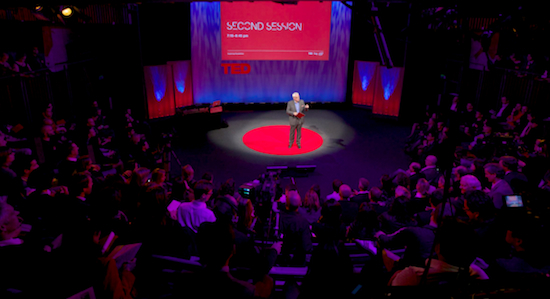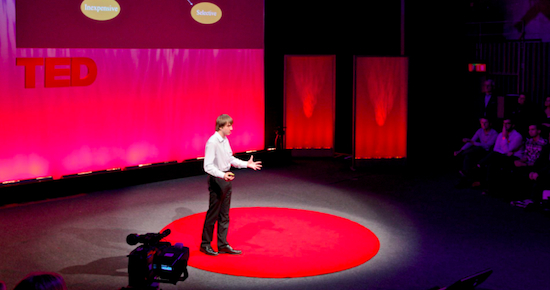Polar explorer Ben Saunders took the stage at the TEDSalon in London on November 7 to ask the question: “If everything is being done somewhere by someone and we can participate virtually, then why bother leaving the house?” A journalist had posed this question to him weeks earlier. He addressed it onstage through both his own experience of skiing alone for weeks at a time, as well as through the eyes of others who have ventured out to answer what he dubbed “the call of the unfinished endeavor.”
Saunders was one of ten speakers featured at the event, which took place at the Unicorn Theatre, supported by TED partners Intel and frog. The evening’s theme was “Exploring Possibilities,” and the 220 attendees heard stories of exploration in an eclectic set of fields: from Saunders’ extreme geographies to the frontiers of science, from the writing of a new national constitution to the creation of new markets.
Hosted by TED’s European director Bruno Giussani, the Salon was opened by NY-based designer E Roon Kang, a TED Fellow who pointed to the “chain reaction of complications” that we bring into our lives and work as a byproduct of our quest for efficiency. (Ever thought of whether your smartphone, besides expanding the scope of your possibilities, has also made your life more complicated and stressful?) His design projects are informed by this paradox, for example when developing the new visual identity for the MIT Media Lab. For that project, with his collaborators, Kang took into account fluidity and ambiguity by avoiding a “fixed” institutional logo in favor of an algorithm that creates, based on set criteria, a different logo for each staffer.
In times of crisis, a general concern is how markets can create new economic opportunities. The second speaker, British policy entrepreneur Wingham Rowan, suggested that in order to expand opportunities, we also need to create new markets. He argued that there is a well of untapped economic potential in online marketplaces where people at every level of the skill scale and with spare hours to “sell” could meet the micro-demand for anything from last-minute warehousing personnel to teaching. Sure, websites likes Craigslist are doing some of this matchmaking already. But they have none of the sophistication, automatization and legal framework of, say, financial electronic markets. “Why only some — rather than all — can benefit from this kind of market infrastructure, where qualified offer and demand can meet and match immediately?” he asked.
Speaking of crisis, while a lot of attention is focused on the Southern edge of Europe (Greece, Italy, Spain, Portugal), up north a small country is digging its way back from a dramatic 2008 financial meltdown: Iceland. One of the answers that the country gave to that crisis was to re-write its Constitution from scratch. (Side note: Unlike most other countries, the UK, where the TEDSalon took place, does not have a document called a “Constitution”: its constitutional law is disseminated across many written and unwritten sources, from treaties to royal prerogatives.) The third speaker was one of the people who led that effort, political scientist Silja Bara Omarsdottir, from the University of Iceland. The new text is ready for a final parliamentary discussion, and it was developed in a very open way, with a citizen assembly, hundreds of proposals submitted, a committee coordinating and having meetings on live webcast, online feedback loops to which every citizen could participate, and more. “It wasn’t crowdsourced,” Omarsdottir said: the committee held control of the text. But it was transparent, open and participatory at an unprecedented scale. “People felt involved, they felt ownership.”
Azerbaijani violin virtuoso Sabina Rakcheyeva was next to take the stage, with a cross-genre performance fusing Eastern and Western influences.
Every year, Intel, one of the TEDSalon’s partners, organizes the world’s largest pre-university science competition, the Intel International Science and Engineering Fair. Millions of high school students around the globe take part, and the event plays a major role in motivating young people towards science. The winner of the 2012 Fair, Jack Andraka, is 15, and was awarded first place for developing a new method to detect pancreatic cancer. He explained how he researched the illness on the Web after a close family friend died of it, and hit upon a potentially interesting approach after smuggling into biology classes (“a stifler of innovation”) a science article about carbon nanotubes. Andraka said he wrote 200 letters to professors before finding someone willing to give him a chance and access to a facility at Johns Hopkins University. It took him many months, “and a lot of mistakes,” but he did succeed in creating a new, better, cheaper, simpler and more effective “sensor” for pancreatic cancer.
The Salon took place the day after the US presidential election — a big news day. The news ecosystem has been shaken up in recent years by ubiquitous cellphone/Twitter/YouTube reporting. Many important recent stories have been reported this way, from war zones, catastrophe areas and more. In many cases, however, the source of information may not be immediately recognizable or verifiable. Markham Nolan, editor of Storyful, spoke about methods to validate crowdsourced news. He detailed an example related to a gruesome piece of video footage filmed in Hama, Syria, showing dead bodies being thrown into a river from a bridge — and how via the aerial images of Google Maps and a series of other online tools it was possible to identify with certainty the place and verify the credibility of one of the three sources. “But while tools and algorithms can check and channel all this information, truth is fluid and human — and will forever remain a uniquely human trait.”
Geopolitical analyst Parag Khanna was next, introducing the concept of “Hybrid Age,” the age in which we are living, which is characterized by the blurring of traditional boundaries — between disciplines, between cultures, between political structures, between biology and technology. Earlier this year Khanna co-authored a TEDBook on this topic, Hybrid Reality, and in his talk he explored the impacts of these developments on work and political systems, advancing the idea of the TQ, the “Technology Quotient,” measuring an individual’s (or an organization’s, or a State’s) adaptability and preparedness for emerging technologies and the need to integrate and leverage them. After his talk, while answering questions from Bruno Giussani, he discussed North Korea, which he recently visited, and the massive railroad projects that — with Chinese financial backing — may in a not-so-distant future link up Eurasia, the landmass that goes from Europe to Vladivostok and Singapore. It is the biggest landmass on Earth and includes most of its inhabitants.
UCL neuroscientist Molly Crockett took the stage with a cautionary talk about the nature of the recent advances in her discipline, and how in particular brain scan images and data can be used and misused. Newspapers publish daily stories based on neuroscience results. But Crockett pointed at products sold with brain images on them that actually have no science to support the marketers’ claims, and at hand-picked study results used to support theories (and news stories) that the same results could also disprove. “The promise of neuroscience has led to high expectations and unproven claims. But we haven’t yet found a ‘buy’ button in the brain. We cannot tell if someone is in love by looking at their brains. Brain scans cannot read people’s minds. We have to be careful not to let these sorts of claims take away from the actual science of neuroscience.”
A performer who is very adept at exploring the future of music followed: Tim Exile. On top of creating a special performance for the TEDSalon, Exile also brought back Sabina Rakcheyeva for a surprise duet between two virtuosos, one playing the violin, the other playing an impressive array of electronic tools, creating a mesmerizing musical moment.
Back to science — to using genetic engineering to fight one of the deadliest viruses, dengue fever. Dengue affects tens of millions of people every year, and is becoming increasingly lethal as it travels north. A British company, Oxitec, believes it has found a technology that’s more effective and much less damaging to the environment than the currently used chemicals and pesticides: They genetically modify male mosquitos so that they cannot procreate. It’s controversial, like every time the words “genetic engineering” are used. But CEO Hadyn Parry calmly described the problem, and his team’s solution: while genetically modified crops are about giving crops an advantage, Parry said, “we use the same techniques for the exact opposite end: to introduce in the insects a big disadvantage — basically, birth control for mosquitos”.
The closing speaker was TED Fellow Rachel Armstrong, a doctor working at the intersection of biology and architecture at the University of Greenwich. She offered an exploration of designing and manufacturing with living materials. And she did so using a clever rhetorical device. “How might we design a chicken?” she asked. A metaphorical chicken, of course. But that allowed Armstrong to detail the principles of design that would apply to living materials — materials “that know what they are to become.”
Giussani took the opportunity of the TEDSalon to announce the publication of the newest issue of Design Mind magazine, published by TED partner frog and completely devoted to the TEDGlobal 2012 conference, which took place last June in Edinburgh, and to its theme of “Radical Openness.” The magazine, which is available online, expands on the theme through interviews, essays and graphics, including a debate about the connected world between Clay Shirky and Don Tapscott. TEDGlobal 2013 will take place June 10-14, 2013, in Edinburgh.
(Photos by Robert Leslie. TEDster Nesta Morgan was in the audience and sketched some of the attendees).


Comments